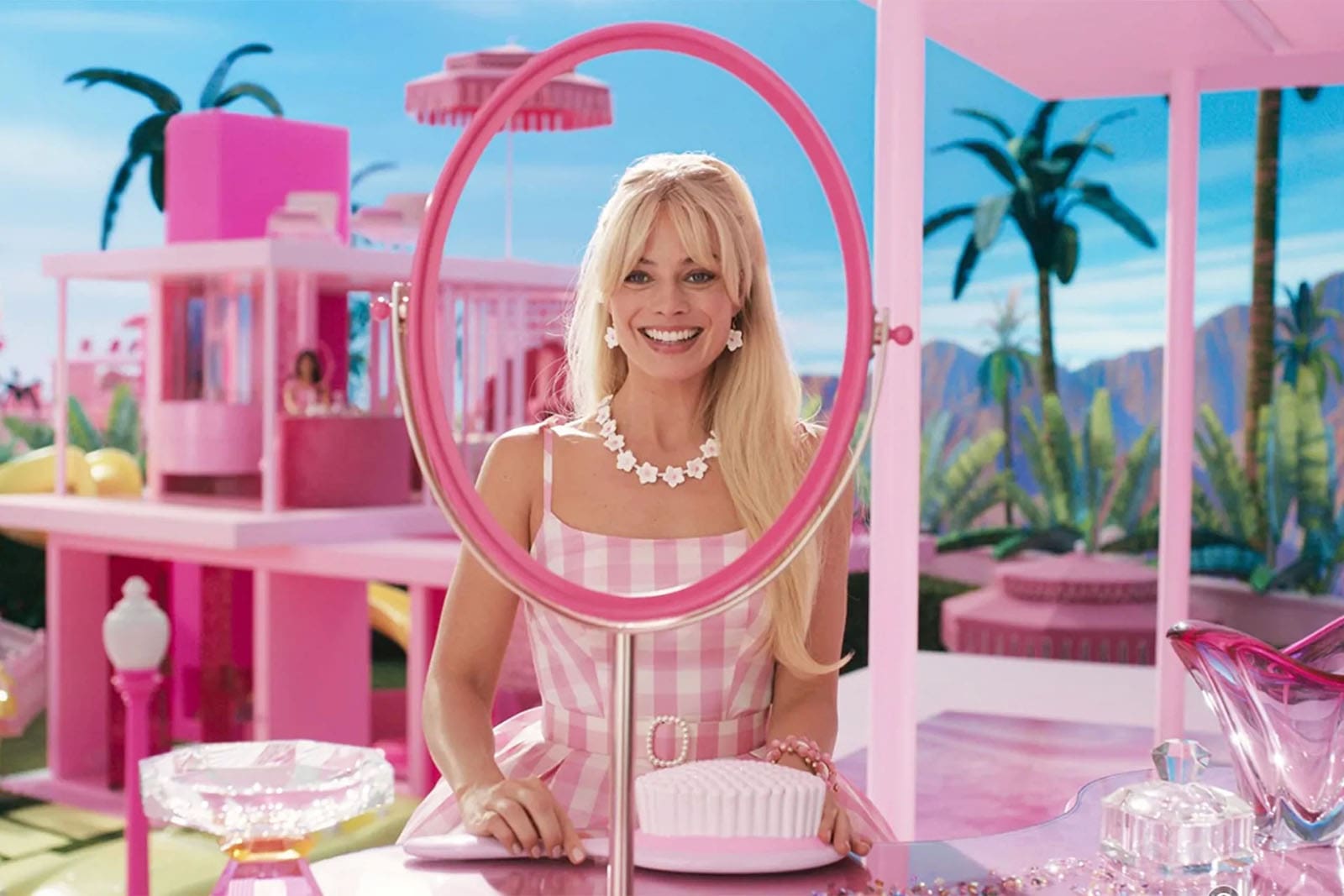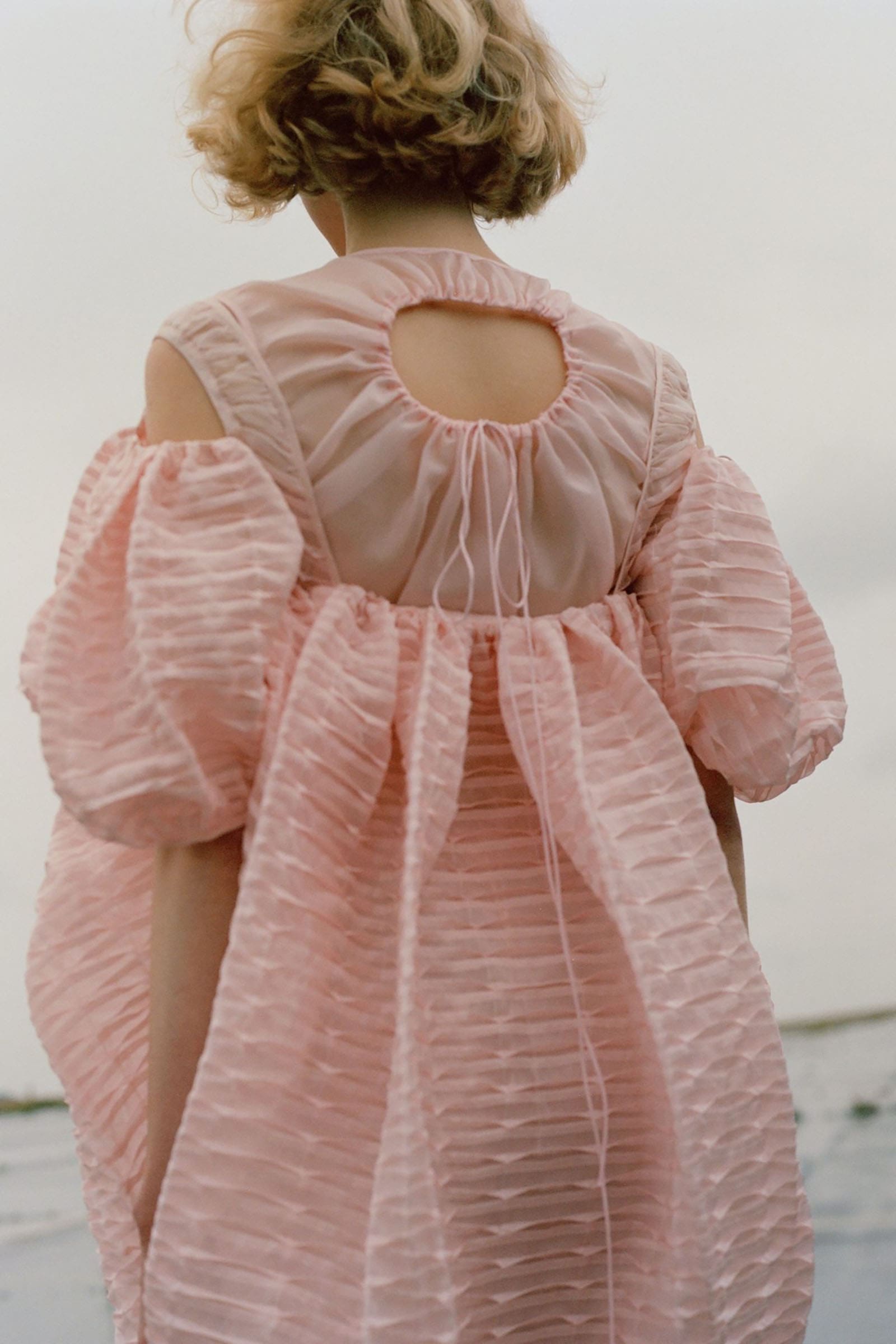Sandy Liang fall ’23. Image credit: courtesy of Sandy Liang
The sweet subversiveness of the aesthetic has deep set psyche appeal.
Whether it’s the enduring reign of Barbie-core, the triumphant return of sweet buckled Mary-Jane shoes (worn by everyone from Zoë Kravitz to Margaret Qualley on her wedding day) and headbands, and the cult following for brands such as New York label Sandy Liang and British label Molly Goddard with her froths of colourful tulle, girlishness is skipping back into trend.
Or more pertinently, as Kristina Stankovski, a curator in fashion and dress at the Powerhouse Museum in Sydney notes, it never really left. In any case, ‘girly fashion,’ has always been up for interpretation, and subversion.
“I think aspects of [girly dressing] are ever-present in women’s fashion. If you think about Rockabilly girls for instance, with their bobby socks and ’50s swing dresses, that ‘girly’ influence is a constant. We have an outfit by Akinori Isobe, the founder of the Baby, the stars shine bright label, in the Powerhouse Collection based on the Elegant Gothic Lolita look, which was popular with fans of ‘visual rock’ bands in Tokyo in the late ’90s. But it’s a somewhat subversive interpretation of dress and perhaps not one many of us would dare attempt,” says Stankovski.
This sense of subversion abounds in modern designers too. It can be found at Sandy Liang, whose collections include pinafores and bows aplenty, as well nostalgic fleeces paired with utilitarian shoes such as Salomons. It’s there in the dark edges of Irish designer Simone Rocha’s ultra feminine collections and the off-kilter kookiness of Miu Miu (not to mention the pants-less trend the brand kicked off).
Anyway, as the Barbie movie reminded us all, women can be everything!

Liane Wiggins, head of womenswear at Matches Fashion, agrees there’s always been a customer for this look. She says it’s not so much about looking back as it is creating a look that feels both now, and super personal.
“This aesthetic has always appealed to our customer and although it is reminiscent of a lot of peoples childhoods, it also feels very modern now with brands such as Cecilie Bahnsen, Simone Rocha and Shushu Tong taking on the trend in a new way—perfectly mixing modernity with whimsical, feminine silhouettes and details,” she says.

Wiggins believes the look also allows women to experiment and be contrary in the way they dress.
“I think most women like the mix of masculine and feminine whilst dressing this way and a full whimsical skirt from Simone Rocha can be toughened up with an oversized sweater tucked in or a studded ballet flat. Junya Watanabe, Comme des Garcon do this look really well with a more modern edge,” she says.
Stankovski says there’s more to the girlishness trend than femininity, subverting it or otherwise.
“I suspect the appeal for some is that these design flourishes call to mind their childhood, or a feeling of carefree innocence that can seem far removed from present circumstances. The retreat to the warmth of girlhood is probably also driven by what’s happening in the world today. The world is beset by so many crises, from the Covid-19 pandemic to climate change, economic woes and war, it’s only natural for designer‘s to respond to it. In some cases, that takes the form of playful designs steeped in cultural nostalgia,” she says.
In any case, nostalgia has long filtered through fashion. Who doesn’t want to look back with rose tinted glasses, and also reimagine the way we were?
Anna Sui, whose grungy babydoll dresses in the ’90s are another prime example, once said of her inspirations, “My clothes are about nostalgia and memories of my own childhood.”
It’s a feeling shared by Sandy Liang. Her first big hit piece was a fleece inspired by her childhood wardrobe. But as Liang said in a piece for the New York Times, sometimes this nostalgia can have a downside. “I’m obsessed over something that I can actually never return to,” she said in the piece.

But despite the youthfulness of the look, Wiggins certainly doesn’t think it’s one confined to only the young.
“This aesthetic can be worn and styled in many ways for a variety of customers depending on their personal style. Sometimes the perception is that it only appeals to a younger customer but I personally love a full skirt styled with an oversized tee, ankle boot or loafer and sheer socks. I also love Cecilie Bahnsen’s Alberto shirt dress which is exclusive to MATCHES styled with denim and a pair of Le Monde Beryl ballet flats. Coats with a Peter Pan collar or a bomber jacket from Simone Rocha or Ashlyn styled with a voluminous skirt or a slim trouser is another modern way to try the trend,” she says.
Still, the desire to reframe femininity and to capture the freedom and innocence of childhood persists. For Celenie Seidel, senior womenswear lead at luxury retailer Farfetch, it’s about reframing how we think about girlishness.

“This trend is more about the reclaiming and re-contextualising of femininity—dismantling the fragility historically associated with a very soft and delicate aesthetic, and re-shaping it in a way that makes sense for where we are in 2023,” she says.
Listing brands such as Renaissance Renaissance, Ester Manas, Simone Rocha and Molly Goddard as her go-to for this aesthetic, Seidel says wearing it today, as a proper grown-up, is about doing it your own way. After-all, the best thing about dressing as an adult is knowing your own style (and wearing what you want).
“It’s about turning this aesthetic on its head a little I feel—extracting elements that make sense for your personal style and finding ways to work them into new combinations with existing pieces you own. For example, something like a delicate cardigan and slip dress layered over jeans with ballet flats takes this trend into a very wearable space,” she says.
A version of this article was first published on The Australian
